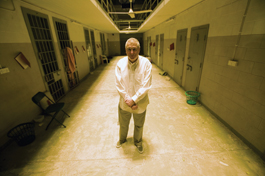home | metro silicon valley index | movies | current reviews | film review

Photo by Nubar Alexanian ©2007 Max Ave Productions
Behind the Walls: Errol Morris looks at the physical and psychological reasons for the Abu Ghraib abuses in 'Standard Operating Procedure.'
Hellmouth
'Standard Operating Procedure' documentary looks at the metadata about Abu Ghraib
By Richard von Busack
THE MORAL of Errol Morris' Standard Operating Procedure is that understanding all doesn't always mean pardoning all. Understanding all (or at least, understanding more) is the opposite of healing and closure. The wacky adventures of the 800th MP Brigade in Iraq have been officially punished, with the bad apples stashed in a bad-apple cellar. Cpl. Charles Graner, who got the longest sentence in the stockade, is unavailable for the cameras until sometime in the next decade. But Morris got to talk to Lynndie England, and she was the one who stuck in the mind from the first. She was like the gleeful rabid chipmunks in Happy Tree Friends, smiling cockily over some sex torture. That tomboy grin was as essential to the shock of Abu Ghraib as the image of "Gilligan," the dunce-capped, wired-up figure standing on his crate. England's hair is longer now, making her look younger and more vulnerable. We have the reformed England: a woman scorned, a good mother whose only thought is of her child. Mistakes were made. (By whom? By what? Made by other mistakes?) The film does explain how the atmosphere of torture breaks out, with pressure without and within. There were some genuine "bad apples" in the stinking bug-filled prison. Funny thing about prisons: every prisoner is innocent, and yet every prisoner knows that there are some people who belong in prison. The CID's Brent Pack explains how computer probing found the "metadata" to sync the digital cameras that took the photos. This established near exact dates and timing. We know so exactly that England can tell us that when her lover, Graner, got a prisoner to masturbate, it was meant as "a present" for England's 21st birthday.
Always explain, never apologize, is the S.O.P. There is some use of the Nuremberg defense of course. And we learn, as Rumsfeld put it, there are some "known unknowns" here. Mostly about the "ghosts," the unlogged-in prisoners of nameless intelligence operatives, brought in for—well, what? Something worse than what we saw. Standard Operating Procedure isn't displaced by earlier and less impressionistic accounts of the scandal. Morris brings something new, though: distance and style and emphasis, as well as telling details and the sense of time going off-kilter. He gives us the thunder of music (Danny Elfman doing a tribute to Philip Glass), and the slow motion of an enormous guard dog towering over the camera. We see fantasy, too: mountains of shredded paper in a prison hallway, stirred by ceiling fans.
Under the more familiar images of the stupid frat-house clowning and hazing, Morris shows us the pathetic qualities of the participants, such as the child-size England, photographed in her sleep. And Morris isn't dispassionate; we can see his rage at what was acceptable. What happened to "Gilligan" was officially mere psychological torture. "No one would believe the shit that goes on," Spc. Sabrina Harman said, taking photos to force that belief. Who could believe it could ever be forgotten? But who could believe that My Lai could be forgotten? Morris shows us that a personal history is like national history. It's a simple matter of getting the story straight.
![]() STANDARD OPERATING PROCEDURE (R; 118 min.), a documentary by Errol Morris, opens May 9 at Camera 2 in San Jose.
STANDARD OPERATING PROCEDURE (R; 118 min.), a documentary by Errol Morris, opens May 9 at Camera 2 in San Jose.
Send a letter to the editor about this story.
|
|
|
|
|
|